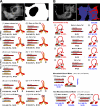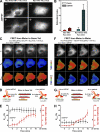Kinesin-1 structural organization and conformational changes revealed by FRET stoichiometry in live cells
- PMID: 17200416
- PMCID: PMC2063625
- DOI: 10.1083/jcb.200605097
Kinesin-1 structural organization and conformational changes revealed by FRET stoichiometry in live cells
Abstract
Kinesin motor proteins drive the transport of cellular cargoes along microtubule tracks. How motor protein activity is controlled in cells is unresolved, but it is likely coupled to changes in protein conformation and cargo association. By applying the quantitative method fluorescence resonance energy transfer (FRET) stoichiometry to fluorescent protein (FP)-labeled kinesin heavy chain (KHC) and kinesin light chain (KLC) subunits in live cells, we studied the overall structural organization and conformation of Kinesin-1 in the active and inactive states. Inactive Kinesin-1 molecules are folded and autoinhibited such that the KHC tail blocks the initial interaction of the KHC motor with the microtubule. In addition, in the inactive state, the KHC motor domains are pushed apart by the KLC subunit. Thus, FRET stoichiometry reveals conformational changes of a protein complex in live cells. For Kinesin-1, activation requires a global conformational change that separates the KHC motor and tail domains and a local conformational change that moves the KHC motor domains closer together.
Figures








Comment in
-
Jump-starting kinesin.J Cell Biol. 2007 Jan 1;176(1):7-9. doi: 10.1083/jcb.200611082. J Cell Biol. 2007. PMID: 17200413 Free PMC article.
Similar articles
-
The auto-inhibitory domain and ATP-independent microtubule-binding region of Kinesin heavy chain are major functional domains for transport in the Drosophila germline.Development. 2014 Jan;141(1):176-86. doi: 10.1242/dev.097592. Epub 2013 Nov 20. Development. 2014. PMID: 24257625 Free PMC article.
-
Sunday Driver/JIP3 binds kinesin heavy chain directly and enhances its motility.EMBO J. 2011 Jul 12;30(16):3416-29. doi: 10.1038/emboj.2011.229. EMBO J. 2011. PMID: 21750526 Free PMC article.
-
Kinesin's light chains inhibit the head- and microtubule-binding activity of its tail.Proc Natl Acad Sci U S A. 2010 Jun 29;107(26):11781-6. doi: 10.1073/pnas.1005854107. Epub 2010 Jun 14. Proc Natl Acad Sci U S A. 2010. PMID: 20547877 Free PMC article.
-
Interaction of kinesin motors, microtubules, and MAPs.J Muscle Res Cell Motil. 2006;27(2):125-37. doi: 10.1007/s10974-005-9051-4. Epub 2005 Dec 17. J Muscle Res Cell Motil. 2006. PMID: 16362723 Review.
-
Directionality of kinesin motors.Acta Biochim Pol. 2002;49(4):813-21. Acta Biochim Pol. 2002. PMID: 12545188 Review.
Cited by
-
Miro GTPase domains regulate the assembly of the mitochondrial motor-adaptor complex.Life Sci Alliance. 2022 Oct 27;6(1):e202201406. doi: 10.26508/lsa.202201406. Print 2023 Jan. Life Sci Alliance. 2022. PMID: 36302649 Free PMC article.
-
Quantitative transportomics identifies Kif5a as a major regulator of neurodegeneration.Elife. 2022 Mar 8;11:e68148. doi: 10.7554/eLife.68148. Elife. 2022. PMID: 35259089 Free PMC article.
-
Recycling of kinesin-1 motors by diffusion after transport.PLoS One. 2013 Sep 30;8(9):e76081. doi: 10.1371/journal.pone.0076081. eCollection 2013. PLoS One. 2013. PMID: 24098765 Free PMC article.
-
JIP1 and JIP3 cooperate to mediate TrkB anterograde axonal transport by activating kinesin-1.Cell Mol Life Sci. 2017 Nov;74(21):4027-4044. doi: 10.1007/s00018-017-2568-z. Epub 2017 Jun 21. Cell Mol Life Sci. 2017. PMID: 28638935 Free PMC article.
-
BicD and MAP7 Collaborate to Activate Homodimeric Drosophila Kinesin-1 by Complementary Mechanisms.Traffic. 2025 Apr-Jun;26(4-6):e70008. doi: 10.1111/tra.70008. Traffic. 2025. PMID: 40384341 Free PMC article.
References
-
- Adio, S., J. Reth, F. Bathe, and G. Woehlke. 2006. Review: regulation mechanisms of Kinesin-1. J. Muscle Res. Cell Motil. 27:153–160. - PubMed
-
- Coy, D.L., W.O. Hancock, M. Wagenbach, and J. Howard. 1999. Kinesin's tail domain is an inhibitory regulator of the motor domain. Nat. Cell Biol. 1:288–292. - PubMed

